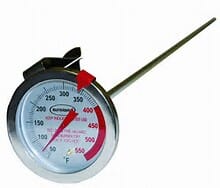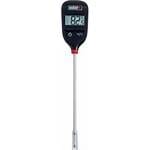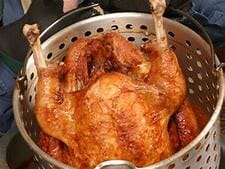A few years ago my daughter’s in-laws from Brooklyn NY came to Memphis for thanksgiving. To give them a taste of southern cuisine I decided to fry a turkey in addition to my conventionally roasted turkey. In effect we had a taste panel where our twenty guests got to try both a roasted and fried turkey. There was no question that the fried turkey tasted better. It was more savory and had a richer flavor. It gave new meaning to the saying: “you can fry anything and it will taste better”.
Fried turkeys are great, but frying is dangerous. Every year deep-fryer fires are responsible for five deaths, 60 injuries, the destruction of 900 homes, and more than $15-million in property damage, according to the National Fire Protection Association.
I had a neighbor who once almost burned down his house. The poor guy thought you had to have the oil boil before putting the turkey in. He was lucky he didn’t kill himself. He did however set his house on fire. The funny part of the story was that my buddy just happened to be wearing a tee shirt that said “Chicago Fire Department”. When the local fire department got to the house my freind noticed one of the firemen looking at his shirt quizzically. My buddy told him the shirt was a gift. To which the fireman responded: “I figured”.

With all this said, there are six keys to safely frying a turke
- Get a smaller turkey that fits in your fryer
A turkey in the 12 to 15 pound range will work well. Most turkey fryers will fit a turkey of less than 15 pounds. Larger turkeys increase the chances of oil overflow. The smaller turkey also cooks quicker and more evenly. If you are having larger crowd you may need to fry more than one turkey. The good news is that it only takes about 35 to 45 minutes to fry a turkey so cooking two should be no problem.2
2. Make sure your turkey is fully defrosted and brought to room temperature
If you want a real disaster try putting a frozen turkey in hot oil. There are some hilarious videos on the internet, but if it happens in real life the explosion isn’t funny at all. I like to use a fresh turkey and even with that I will take the a turkey out of the refrigerator for a couple of hours prior to frying to make sure it is at room temperature
3. Pre-measure how much oil to put in your fryer
I like to place my turkey in the cold fryer before cooking. Then I fill the fryer wiith water to get the turkey fully covered. You then pull the turkey out and mark how much water is in the fryer. Then empty the water out. Fully dry the pot and fill the fryer with oil up to your mark
4. Fry your turkey outside away from anything that will catch on fire
This seems like an obvious one, but you can’t be too careful. Again there are stories where people have fried a turkey inside or even on a wooden deck that just don’t end well
5. Use an fry oil thermometer and take precaution when lowering the turkey into the oil
Heat your oil to 250 degrees and then slowly lower it in. The biggest risk is the first time you lower the turkey into the oil. The risk is the oil bubbling over and igniting with the flame. I use the a hook unit that comes with the fryer and wearing heat resistant cooking gloves and a large sturdy fork to lower the bird in without getting burned. Once the turkey is in, I then bring the oil temperature up to 350 degrees and cook for 35 minutes

6. Use an instant read thermometer to make sure the bird is done.
After the bird has cooked for 35 minutes I pull it out with the hook, gloves and fork. Then using an instant read thermometer I make sure the internal temp is 155 degrees. After the turkey is out of the oil it will continue to cook and should reach 165 degrees. The bird should rest for at least 20 to 30 minutes before carving.

In the end fried turkey is better and with these 6 keys it can be done safely.
If you enjoyed this blog and similar other stories/supper club lessons follow me on Facebook and Twitter and subscribe to get future blogs at www.impromptufridaynights.com/blog and check out my book Impromptu Friday Nights a Guide to Supper Clubs. Published by Morgan James Publishing and available through most channels where books are sold.
